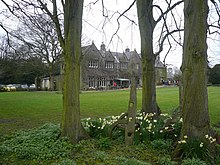Teversal
History
Teversal (called Tevershall) is the site of fictional Wragby Hall, the home of Lady Chatterley in the novel Lady Chatterley's Lover by D. H. Lawrence.
As part of the history of Beauchief Abbey, Sheffield in 1190-1225 William Barry, Lord of Teversal was granted two tofts and crofts in Stanley, a hamlet within the Teversal area. The grant meant that there was sufficient area for a farm. The land now is now Stanley Grange Farm. In 1525 Thomas North owned the Grange, where he kept his sheep. In 1537 William Bolles owned the Grange, he was a receiver of the governments dissolved monasteries at the time. Bolles later owned Felley Priory after the priory was dissolved in 1536, as part of King Henry VIII's Dissolution of the Monasteries.
Teversal is a former civil parish and had a population of 946 in 1931. On 1 April 1935 the parish was abolished and the area became part of the parish and urban district of Sutton in Ashfield. Sutton in Ashfield Urban District was in turn abolished in 1974 to become part of the new district of Ashfield. No successor parish was created for the former urban district and so Teversal is directly administered by Ashfield District Council.

Teversal Manor

Prior to 1562 Roger Greenhalgh owned Teversal Manor. The Manor was then transferred to Francis Molyneux the son in law of Roger in 1582. Francis Molyneux, the High Sheriff of Nottinghamshire between 1582 and 1583 owned Teversal Manor with Francis's grandson John Molyneux being the High Sheriff in 1609. John became the first Baronet of Teversal. The Molyneux baronets and families remained in the village for about 150 years. The Molyneux family were an ancient Norman family.
Teversal Manor was passed to Sir Francis Molyneux, 7th Baronet in (1738-1812). Sir Francis became the Gentleman Usher of the Black Rod. On his death passed the estate of Teversal Manor to Lord Henry Howard-Molyneux-Howard.[41] Lord Henry's eldest daughter was Henrietta Anna Howard-Molyneux-Howard who married Henry Herbert, 3rd Earl of Carnarvon in 1830.
Teversal Manor was passed to Henrietta. The Carnarvons retained the manor which was then passed to the son of the 3rd Earl to Henry Herbert, 4th Earl of Carnarvon, who was a British cabinet minister and Lord Lieutenant of Ireland who married Elizabeth Catherine Howard otherwise known as Elsie. Elsie used the Manor at Teversal for refugees. His son George Herbert, 5th Earl of Carnarvon, and his wife Almina were associated with Howard Carter and funded the excavations of Tutankhamun's tomb in 1922.
Aubrey Herbert, the half Brother of the 5th Earl of Carnarvon, celebrated his coming of age birthday at Teversal Manor. Teversal Manor was visited by the author Virginia Woolf in 1904.

Church
St Katherine's Church is a Grade I listed building.

Teversal Trails
The Teversal Trails are a series of paths on the route of old railway lines. The Visitor Centre is located nearby with a car park that serves the football, cricket and bowls clubs. The trails link into the Skegby/Pleasley Trails, with others leading into Silverhill.

See also
References
Constructs such as ibid., loc. cit. and idem are discouraged by Wikipedia's style guide for footnotes, as they are easily broken. Please improve this article by replacing them with named references (quick guide), or an abbreviated title. (January 2022) |
- ^ Faulkes, Heather (22 April 2004). "A History of Teversal". Retrieved 3 January 2010.
- ^ The Nottinghamshire Village Book (Newbury: Countryside Books, 1989), p. 157.
- ^ "Ashfield District Council - Teversal Village and St Katherine's Church". www.ashfield.gov.uk. Retrieved 7 November 2020.
- ^ Pegge, An Historical Account of Beauchief Abbey 1801, p. 143. Biggin Farm is at SK 445626 Accessed on 23 August 2020 ^ "Introduction". Cambridge Core. Retrieved 29 September 2020.
- ^ Ibid., p. 67, appendix 10 Bolles also got Felling abbey (Notts)
- ^ "Population statistics Teversal AP/CP through time". A Vision of Britain through Time. Retrieved 22 March 2023.
- ^ "Relationships and changes Teversal AP/CP through time". A Vision of Britain through Time. Retrieved 22 March 2023.
- ^ "The English Non-metropolitan Districts (Definition) Order 1972", legislation.gov.uk, The National Archives, SI 1972/2039, retrieved 31 May 2023
- ^ "Felley Priory". bl.uk. 29 March 2009. Retrieved 23 August 2020.
- ^ "The Manor House". 6 June 2008. Archived from the original on 6 June 2008. Retrieved 7 November 2020.
- ^ "Nottinghamshire history > H Walkerdine and A S Buxton, Old churches of the Mansfield Deanery (1907)". www.nottshistory.org.uk. Retrieved 7 November 2020.
- ^ Cite 8th Countess of Carnarvon, Lady Almina and the real Downton Abbey, the lost legacy of Highclere Castle, 2011, Broadway Paperbacks, PDF format found online retrieved on 25 August 2020
- ^ Hermione Lee (1997). Virginia Woolf. Vintage. p. 203. ISBN 978-0-09-973251-8. Retrieved 22 August 2020
- ^ "Ashfield District Council - Teversal Village and St Katherine's Church".
- ^ "Teversal Trails". nottinghamshire.gov.uk. Retrieved 8 February 2023.